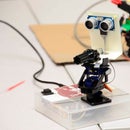Introduction: Organizing Your ICs, Resistors, Caps, Etc With Datasheets!
If you are like me, keeping track of what parts you have and trying to get all the datasheets organized is an almost impossible task. Until recently I had parts in ten different bins, datasheets spread all around my work bench and folders in who-knows-where on my computer.
This Instructable is my answer to this problem.
Step 1: Parts
There are not very many things that you will need, and they are all very cheap. The things that you will need are:
1. Something to organize. In all likelihood you already have this as you are already reading this.
2. Google Drive Account. This will be how we organize our datasheets. The alternate is a spreadsheet in Open Office, Excel, or on you Mac.
3. Labels. I used Avery 18163 Labels. They were big enough that I could see what I put on them, and still fit a decent size QR code (as seen in steps 6 and 7 ).
4. Hanging folders. I chose to use folders of all one color, for reasons laid out in step .
5. A hanging folder bin, or file cabinet. The more chips that you have, the bigger or more of these you will need.
I had most of the parts on-hand, so I spent less than $10. In all, I priced this method out at less than $30.
Step 2: Google Drive Template
The first step is to get all of your chips together, and to fill out the template I have provided. The template is a .csv file that can easily be opened in Excel, Google Drive, or Open Office.
In the template here are several different columns. You can customize this list to your hearts content. I've explained what I've put in and why below.
Name -- This is the name of the category of chip. I currently have the following sets: REGULATOR, RTC, MCU, EEPROM, MULTIPLEXOR, I/O EXPANDER, OP AMP, and the list goes on. You can add in any category you want.
Description -- A short description of what the part is. This is text that can help you understand what the part is used for.
Quantity -- The quantity of the part on hand. This is useful when you are working on a project and need to know how many parts you have. It also allows you to keep records and datasheets around even if there are zero parts left.
Location -- The bin in which the parts are to be located. I have two bins, a black one and a blue one. If you have a file cabinet with parts, you can label or number the drawers.
Index -- This a unique number assigned to each IC. I started at 1 and numbered up.
IC Package -- This is the package type of the IC followed by the number of pins. For example, an ATMega328 is a DIP 28 package. Other common packages include TQFP, SOIC, and TO-220. This column is very useful if you have multiple packages of the same part. Each different package has a different row in the sheet. For example: an ATMega328 in DIP 28 and in SOIC would have two different lines, so I can accurately track each.
CAD Model -- This is a link or name of the file where the CAD file for Eagle or KiCAD resides. This will allow you to quickly find the part in your library when laying out PCBs.
Datasheet -- This is the name of the downloaded datasheet in the datasheet directory, as will be shown in step . This is here in addition to Man. URL for when the datasheets are no longer available from the manufacture. Multiple entries are separated by commas, allowing for multiple datasheets/references for the same part.
Man. URL -- This is the hyperlink of the datasheet from the manufacture. This is here in addition to the previous one in case the datasheet changes. Take for example the MSP432 which I have. It is in its experimental phase, and the datasheet is likely to change again. Multiple entries are separated by commas, allowing for multiple datasheets/references for the same part.
Manufacture -- This is who makes the part. This allows you to have the same part (like the LM317) from multiple manufactures and keep them separate if you wish.
Man. Part No. -- This is the number that appears on the packaging of the part; The same one that can be found by searching on the manufacture's website.
Packaging -- This is how the parts are stored. This in small quantities this isn't really important. When you have reels and trays for manufacturing your own boards, this becomes very important.
As noted above, these are what I thought would be the most helpful. You can remove or add to this as you wish. The design of this was to facilitate its eventual update to an SQL database that can be updated from a raspberry pi inventory system that I am working on.
Attachments
Step 3: Labels
There are too many fields, and too much information contained in the spreadsheet to be able to put it on a label. Because of this, I decided on three of the fields that were most important to me, and added them to my labels.
I chose to have the Description, Man. Part No., and IC Package, in plain text on the label. In addition, I have added a QR code that links to the manufacture's datasheet. By scanning this QR code, I can instantly have a datasheet on my phone when working on designing a new circuit.
Making the QR code is steps 6 and 7.
Attachments
Step 4: Folder Organization
I decided to put all my files online as opposed to my computer so that I could access the information anywhere I go. My little blue bin is perfect for travel, so I figured so should my back-end. I've organized my file structure as shown below and in the picture.
>Inventory
--> IC Inventory (spreadsheet)
--> Label template (document)
--> CAD Models
----> KiCAD models (KiCAD .kicad_mod)
--> Datasheets
----> Individual datasheets (mostly pdf)
Step 5: Hanging File Folders
There are many options out there for hanging file folders. I'll discuss a few.
Basic -- These are your basic folders. Really what they are is some cardstock with some metal hangers. Nothing fancy. They hold about 40-60 sheets of paper before they become overfull. For us, they work good for low quantities of parts, or with parts that are small. DIP package chips work when there are less than 10, and when they are in bags or tubes.
Expandable -- These are great for bigger chips and bigger quantities of chips. I've got some of these coming for use with my larger sets of chips. Note that you can get the ones with sides, and those without. Spring for the ones with sides so you don't get chips falling out when you pick up the folder.
Half Size -- These are great little ones that make finding your chips easy. If you have a whole bin full of these, you'd have storage room underneath for other things. If I could have found these at a decent price, I would have gone this route. (For my next project I'm going to take the basics and make them into half size expandable folders.)
Colorful -- While this really could describe the three categories previous, I think it deserves some attention. Colors can help you to better organize your system. Maybe each category of chip gets a different color. Its really up to how creative you can be. I chose to keep it monochromatic so that when I shuffle around the chips it still looks uniform.
Where to purchase hanging files
A quick Amazon search gives us lots of options. Ebay is littered with postings. Another place to look would be Costco, Sams, or an office supply store. I got 50 basic folders for $10 at Costco here in the United States.
Step 6: QR Codes: Introduction
The beauty of a QR code is that it is custom. You can have it show you text, play a video, or re-direct you to a datasheet. In this organization system there are two types of labels.
Container Labels -- Each container has a label on it. This label has a QR code that directs me to my Google Drive where the spreadsheet we set up in step resides. It lets me quickly look at what is in the container without having to page through the folders.
Component Labels -- Each folder which contains one row of chips from the spreadsheet, has a sticker label on it. These are shown in the pictures attached to this step. Note that some of them lack some information. Some of the information, like package type wasn't easy to see without opening anti-moisture packages, so I left them blank. When I open them, I will update my table.
Step 7: QR Codes: the How To
There are lots of places out there that make QR codes, but I chose to use The QRCode Generator. I used this one for two reasons. First it allowed me to see the QR code without a download. I just had to drag and drop the code from the site right into the label template. Second, it allowed me to easily display text instead of a link.
For my QR codes, I first visited a url shortener like Google's to make the long urls short. This served to make the QR code simpler and therefore easier to make small. You don't have to do this part if you don't want to. I personally think that this makes the whole thing look cleaner and more professional.
Step 8: Print
Now that you have your labels all filled out, its time to print them. The Avery labels I chose will work on toner and inkjet printers, but if you can, I would print on a toner printer. Its quicker and smears less.
One word of warning when printing: Make sure that you don't have lines turned on on the tables in Word. If you do, they will print and this just looks bad. You can look at the pictures on this step for an example of that.
Caution: The labels are thick and can easily jam. If you have a bypass tray, use that instead of the normal paper tray. It will reduce jams.
Step 9: Indexing
On each folder I placed a plastic tab. Depending on your folders you may be able to put them on, or they may be a part of the folder itself. In either case, this is the place to put your Index from the spreadsheet in step 2. By putting this there, you will know exactly where to look for your parts. No leafing through folders looking at names.
The ones without a number (clear) are empty and ready for expansion!
Step 10: Finishing Touches
Place Your Labels
I made the choice to place the labels in the upper left hand side of the file folder. This choice is purely ascetic.
Put them in Bins
If you have multiple bins, this is the time where you fill out the spreadsheet with where you are putting your parts. Make sure that you have the right chip in the right folder or this whole thing is essentially worthless. This is a great time to double check that the QR codes work, that the part numbers are right and to make any final changes in your spreadsheet.
Your Done!
You now have a searchable, technology friendly way to organize and keep stock of all your electronics parts. I am always looking for ways to improve my lab, so if you do figure out how to make this better, leave me a comment below and tell me what you've done! I love hearing from people.
Happy Organizing!














